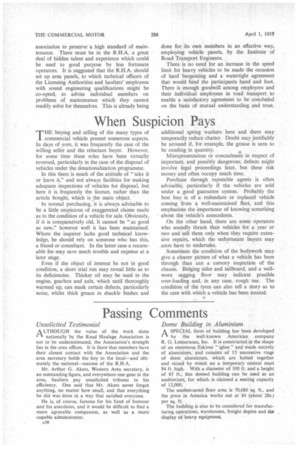When Suspicion Pays
Page 32

If you've noticed an error in this article please click here to report it so we can fix it.
THE buying and selling of the many types of commercial vehicle present numerous aspects. In days of yore, it was frequently the case of the willing seller and the reluctant buyer. However, for some time these roles have been virtually reversed, particularly in the case of the disposal of vehicles under the denationalization programme.
in this there is much of the attitude of "take it or leave it," and not always facilities for making adequate inspections of vehicles for disposal, but here it is frequently the licence, rather than the• article bought, which is the main object.
In normal purchasing, it is always advisable to be a little suspicious of exaggerated claims made as to the condition of a vehicle for sale. Obviously, if it is comparatively old, it cannot be "as good as new," however well it has been maintained. Where the inquirer lacks good technical knowledge, he should rely on someone who has this, a friend or consultant. In the latter case a reasonable fee may save much trouble and expense at a later stage.
Even if the object of interest be not in good condition, a short trial run may reveal little as to its deficiencies. Thicker oil may be used in the engine, gearbox and axle, which until thoroughly warmed up, can mask certain defects, particularly noise, whilst thick grease in shackle bushes and additional spring washers here and there may temporarily reduce chatter. Doubt may justifiably be aroused if, for example, the grease is seen to be exuding in quantity.
Misrepresentation or concealment in respect of important, and possibly dangerous, defects might involve legal proceedings later, but these risk money and often occupy much time.
Purchase through reputable agents is often advisable, particularly if the vehicles are sold under a good guarantee system. Probably the best buy is of a redundant or replaced vehicle coming from a well-maintained fleet, and this emphasizes the importance of knowing something about the vehicle's antecedents.
On the other hand, there are some operators who soundly thrash their vehicles for a year or two and sell them only when they require extensive repairs, which the unfortunate buyers may soon have to undertake.
Sometimes the condition of the bodywork may give a clearer picture of what a vehicle has been through than can a cursory inspection of the chassis. Bulging sides and tailboard, and a wellworn sagging floor may indicate possible over-loading and, in any case, rough use. The condition of the tyres can also tell a story as to the care with which a vehicle has been treated.




















































































































